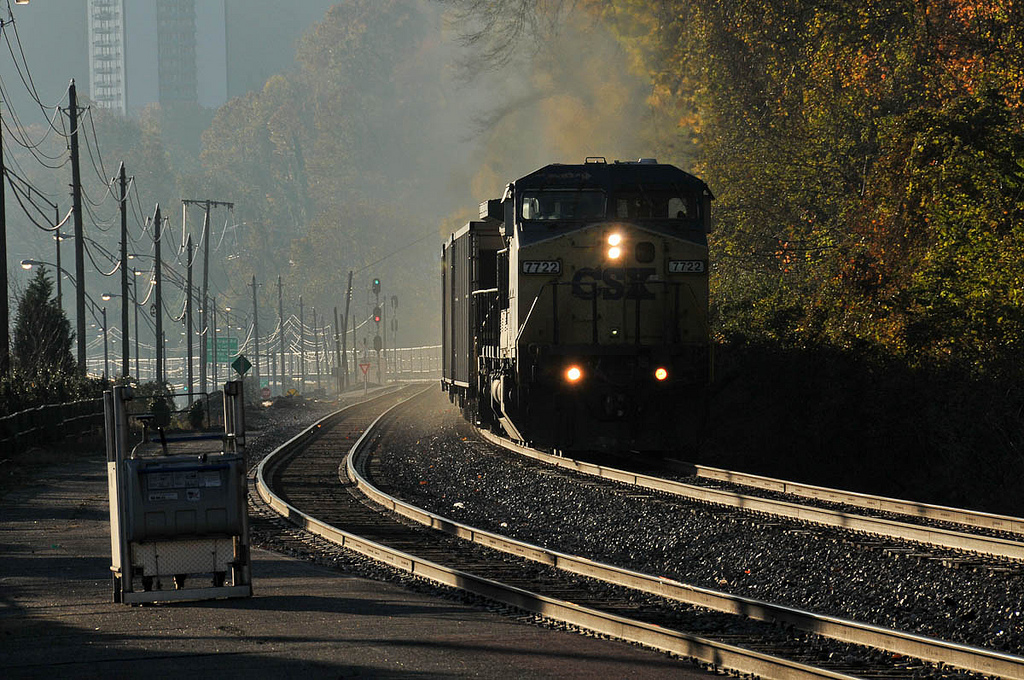So much coal dust escapes from the open-top rail cars used for transporting coal that it can create safety problems for rail traffic. Coal dust deposits sometimes cause spontaneous fires, and in 2005, for example, coal dust that had accumulated in ballast, the layer of crushed rock that supports rail tracks, caused derailments. Given the coal export industry’s designs on the Northwest, it is important for residents to know more about the coal dust hazard.
Industry research is suspect
As much as 3% of a coal car’s load, which is typically 100 tons or more, can blow away in transit.
BNSF Railway has studied the problem (for liability reasons) and found that as much as a ton of coal, including coal dust, can escape from a single loaded coal car. Other reports show that as much as three percent of a coal car’s load, which is typically 100 tons or more, can blow (or bounce) away in transit. The US Department of Transportation classifies coal dust as a “pernicious ballast foulant” that can weaken and destabilize rail tracks. It is not clear how much coal dust might escape in the Pacific Northwest, but one watchdog group has verified that coal and coal dust do escape from open rail cars traveling along Puget Sound coastlines.
If shippers wished to reduce or prevent coal dust from escaping, they could do so by filling cars less full or covering them with tarps or chemical sprays. However, these measures run up the cost of moving coal, so coal shippers prefer not to employ them. A March 2011 ruling from the US Surface Transportation Board, which oversees railway operations, allowed BNSF to require coal shippers to control dust, but many believed the controls would be ineffective. Coal shippers appealed the decision, blaming BNSF’s operating procedures for the spread of coal dust and arguing that the railway’s dust reduction goals were unrealistic and based on “junk science.” The government ruled in favor of the railroads, however, finding that it is possible to control coal dust by means of shaping the coal when it is piled into a railcar and applying chemical topping agents to the coal—the shippers’ responsibility, then, and not the railways’.
Nonetheless, there are good reasons for skepticism about the industry’s research, the so-called “Super Trial” studies, including the fact that much of it is neither peer-reviewed nor available for public inspection. Moreover, the industry’s tests did not evaluate the effectiveness of dust-control measures over long distances, a potential problem for regions like the Northwest that are relatively far from coal mines.
Northwest impacts and special PRB problems
By contrast, published and peer-reviewed scientific research by Dan Jaffe, a professor of atmospheric science at the University of Washington, casts further doubt on the real-world effectiveness of controlling coal dust from rail transport. In 2013 and 2014, Jaffe installed air monitoring equipment on private property near rail lines in Bellingham, Seattle, and the Columbia River Gorge that enabled him to analyze the emissions from hundreds of trains. He concluded that passing coal trains do in fact spread notable quantities of dust. What’s more, a small number of coal trains qualify as “super-dusters,” sending prolific volumes of coal dust into the air, clearly visible to the naked eye, as video evidence shows:
Complicating matters for the Northwest, Powder River Basin (PRB) coal—the type that would be exported from proposed terminals in the region—is notoriously difficult to handle. One technical analysis finds that “PRB coal is extremely friable and will break down into smaller particles virtually independent of how the coal is transported or handled.” According to the study’s authors, “PRB coal represents the extremes of handling problems.”
The same analysis found that:
Spontaneous combustion of coal is a well-known phenomenon, especially with PRB coal. This high-moisture, highly volatile sub-bituminous coal will not only smolder and catch fire while in storage piles at power plants and coal terminals, but has been known to be delivered to a power plant with the rail car or barge partially on fire… [emphasis mine].
Outside of confined environments, PRB coal does not spontaneously explode or burst into full flame, but under the wrong conditions it can self-ignite and burn slowly even while it is riding the rails—a troubling proposition for railroad workers and communities along the tracks throughout the Northwest.
Deric Gruen and Tarika Powell contributed research to this article.
[button link='{“url”:”http://www.sightline.org/2016/04/04/from-montana-to-the-coast-coal-dust-threatens-human-health/”,”title”:”Read more: From Montana to the coast, coal dust threatens human health.”}’]



Comments are closed.